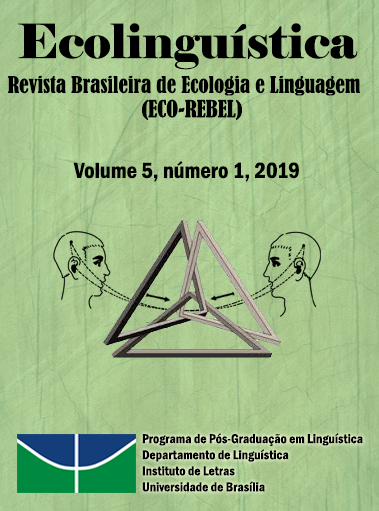Ideas like deer
an ecolinguistic analysis of similes in four nature books
Palavras-chave:
Ecolinguística; símile; EFL; teoria da metáfora conceptual; novo materialismo.Resumo
Os similes enriquecem a língua e enchem a comunicação de imagens. Eles são também uma parte indispensável de qualquer texto sobre a natureza, falado ou escrito. Este artigo investiga similes em quatro livros sobre a natureza, escritos por quatro autores ecologistas de diferentes origens, a partir de uma ótica cognitiva. Levando em consideração a natureza do domínio-origem e do domínio-alvo, cada um deles foi interrogado e, então, agrupado com base em quinze categorias ou variáveis semanticamente significantes. Com isso, descobre-se a motivação por trás de seu uso. Como recursos conceptuais para entender a realidde, os similes são um modo de pensar sobre entidades vivas. Símiles cuidadosamente formados podem ressaltar alguns traços atribuídos a uma miríade de espécies sobre o planeta e, assim, estimular o pensamento sustentável. Finalmente, o artigo discute a importância dos símiles sobre a natureza no context da aprendizagem de língua estrangeira. Acredita-se que o aprendiz de língua deve ser encorajado a escrever sobre a natureza e, simultaneamente, passar a usar símiles criativos que se adéquam ao contexto ecológico.
Downloads
Referências
ABRAM, D. Becoming animal: An earthly cosmology.New York: Vintage, 2010.
ACKERMAN, D. A natural history of the senses. New York: Random House, 1990.
ALAIMO, S.Bodily natures: Science, environment, and the material self. Bloomington: Indiana University Press, 2010.
BAKHTIN, M. The dialogic imagination: Four essays. Austin: University of Texas Press, 1981.
COLIN, N. English and Swedish animal idioms: A study of correspondence and variation in content and expression. University Essay from Karlstads Universitet/Institutionen för Kultur och Kommunikation, 2006.
COOLE, D. & FROST, S. Introducing the new materialisms. In:COOLE,D.;FROST,S.(eds.).New materialisms: Ontology, agency, and politics.London: Duke University Press, 2010, p. 1-43.
CRYSTAL, D. English as a global language. Cambridge, UK: Cambridge University Press, 2003.
FELDMAN, J. From molecule to metaphor: A neural theory of language.Cambridge, Mass: MIT Press, 2006.
GOATLY, A. The language of metaphors. London: Routledge, 1997.
GRIFFITHS, J. Pip pip: A sideways look at time. London: Flamingo, 1999.
IOVINO, S. Material ecocriticism: Matter, text, and posthuman ethics. In:MÅ°LLER,T.;SAUTER,M. (eds.), Literature,ecology, ethics: Recent trends in ecocriticism(pp. 51”“68).Heidelberg: Universitätsverlag Winter, 2012.
JAMIE,K.Sightlines. London: Sort of Books, 2012.
KÓˆVECSES, Z. Metaphor: A practical introduction. Oxford: Oxford University Press, 2010.
LAKOFF, G.;JOHNSON, M. Metaphors we live by. Chicago: University of Chicago Press, 1980.
LAKOFF, G.;TURNER, M. More than cool reason. Chicago: University of Chicago Press, 1989.
LAKOFF, G. The contemporary theory of metaphor. In Ortony,A.(ed.), Metaphor and thought. Cambridge, England: Cambridge University Press, 1992, p. 202-251.
LAKOFF, G. The Neural Theory of Metaphor. In:R. GIBBS, R.(ed.), Cambridge handbook of metaphor and thought. New York: Cambridge University Press, 2008, p.17”“38.
LAZAR, G. Meanings and metaphors: Activities to practice figurative language. Cambridge: Cambridge University Press, 2003.
Leopold, A. A sand county almanac: And sketches here and there. New York: Oxford University Press, 1987.
MARLAND, P. The gannet skull versus the plastic doll's head: Material 'value' in Kathleen Jamie’s 'Findings'. Green Letters: Studies in Ecocriticismv. 19, n. 2, 2015, p. 121-131.
NAESS, A. The shallow and the deep, long-rangeecology movement: A summary. Inquiry: AnInterdisciplinary Journal of Philosophy and the Social Sciencesn. 16, 1973, p. 95”“100.
NETTLE, D.; ROMAINE, S. (2000). Vanishing voices: The extinction of theworld’s languages. Oxford: Oxford University Press.
PETERS, P. Similes and other evaluative idioms in Australian English. In:SKANDERA, P.(ed.),Phraseology and culture in English. Berlin:Mouton de Gruyter, 2007, p. 235-256.
PIERINI, P. Simile in English: From description to translation. Círculo de linguisticaaplicada a la comunicaciónn. 29, 2007, p. 21”“43.
RAKUSAN, J. Cultural diversity in crossing the boundaries between human and animal in language ”“Germanic and Slavic similes and metaphors. Collegium antropologicumv.28, n. 1, 2004, p.171”“181.
SEMINO, E. (2005). Mind style.In BROWN,E. K.;ASHER,R. E.;SIMPSON, J. M. Y.(eds.), Elsevier Encyclopedia of language and linguistics. Amsterdam: Elsevier, 2005, p.142-48).
SHEPHERD,N.The living mountain. Aberdeen University Press, 1997.
STAMENKOVIĆ, D. (2011). Cognitive Semantic Aspects of Animal Similes in English. In:KOVAÄŒEVIĆ, M. et al. (4ds.), SavremenaprouÄavanja jezika i književnosti ”“Godina II/Knjiga I ”“Zbornik radova sa II nauÄnog skupa mladih filologa Srbije. Kragujevac: Filološko-UmetniÄki Fakultet, 2011, p. 187-197.
Downloads
Publicado
Como Citar
Edição
Seção
Licença
Autores que publicam nesta revista concordam com os seguintes termos:
Autores mantêm os direitos autorais e concedem à revista o direito de primeira publicação, sendo o trabalho simultaneamente licenciado sob a Creative Commons Attribution License o que permite o compartilhamento do trabalho com reconhecimento da autoria do trabalho e publicação inicial nesta revista.
Autores têm autorização para assumir contratos adicionais separadamente, para distribuição não exclusiva da versão do trabalho publicada nesta revista (ex.: publicar em repositório institucional ou como capítulo de livro), com reconhecimento de autoria e publicação inicial nesta revista.
Autores têm permissão e são estimulados a publicar e distribuir seu trabalho online (ex.: em repositórios institucionais ou na sua página pessoal) a qualquer ponto antes ou durante o processo editorial, já que isso pode gerar alterações produtivas, bem como aumentar o impacto e a citação do trabalho publicado (Veja O Efeito do Acesso Livre).



3.png)



